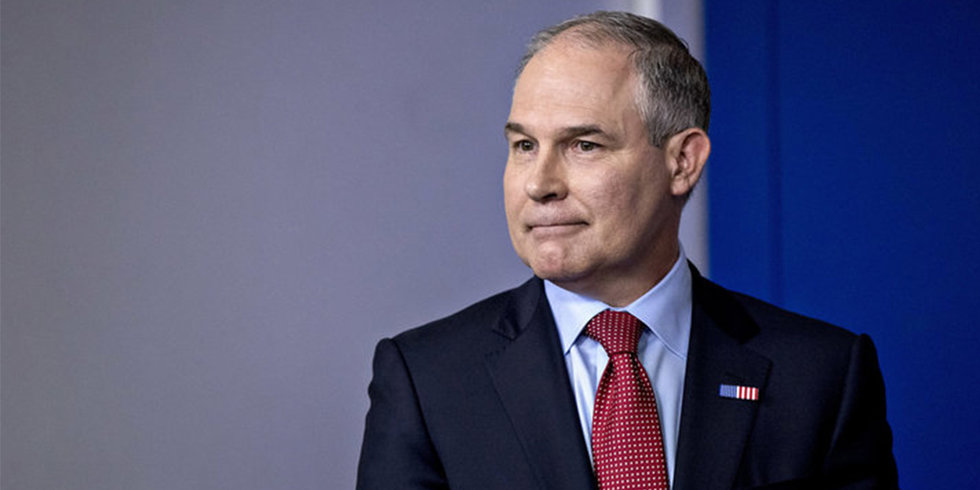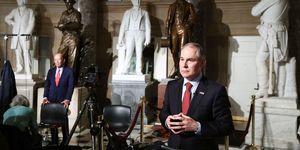Mashable – Science
With Mike Pompeo, Trump will have a hardcore climate denier at State
By Andrew Freedman March 13, 2018
/https%3A%2F%2Fblueprint-api-production.s3.amazonaws.com%2Fuploads%2Fcard%2Fimage%2F732961%2F5a33d612-4410-4cc4-8474-172013b9e0d7.jpg) A protest about climate change in New York City. Image: Lightrocket/Getty
A protest about climate change in New York City. Image: Lightrocket/Getty
Now, climate advocates may miss the ex-oil man, considering his replacement. On Tuesday, Trump fired Tillerson via twitter and announced the nomination of CIA Director Mike Pompeo to lead the State Department in his place.
Pompeo has long-questioned the links between fossil fuel burning and climate change, which climate scientists regard as irrefutable.
In the scientific community, there’s virtually no debate about what is causing global warming based on multiple lines of observational evidence, as well as basic physics.
Next to the president and Environmental Protection Agency administrator, the Secretary of State is the U.S.’s most prominent official on climate change. The State Department is in charge of the nation’s role in international climate talks, including how to walk the delicate dance of working on the implementation of the Paris Climate Agreement while also planning to withdraw from it in 2020, as Trump plans to.
The U.S. is the only country in the world to announce its withdrawal from this agreement, which seeks to keep global warming to “well below” 2 degrees Celsius, or 3.6 degrees Fahrenheit, of warming compared to preindustrial levels by the year 2100.
For his part, Pompeo is a former Republican congressman from Kansas and a member of the Tea Party movement.
He also has longstanding, close ties to Charles and David Koch, the billionaire conservatives who continue to fund efforts to discredit mainstream climate science and sow doubt among the public. In fact, he is the duo’s top funding recipient currently in the Trump administration, having taken in more than $1 million during his time in Congress.
Pompeo declined to state his views on climate change during confirmation hearings for the CIA post, arguing it was outside the scope of the position despite the fact that global warming poses an array of national security threats.
He has made past statements, though, that clearly indicate where he stands on this issue.
“Look, I think the science needs to continue to develop. I’m happy to continue to look at it,” he said on C-SPAN in 2013. “There are scientists who think lots of different things about climate change. There’s some who think we’re warming, there’s some who think that the last 16 years have shown a pretty stable climate environment.”
He has also revealed that he questions whether global temperatures are increasing, and if so, if human activities are the main cause.
Pompeo also criticized the Obama administration’s work on the Paris Agreement, calling it a “radical” treaty.
Once in office, Tillerson was seen as a comparatively moderate voice on climate change, advocating that the U.S. stay in the Paris Climate Agreement, for example.
However, under Tillerson, the U.S. had not yet issued a report on its climate actions due to the U.N. on March 1, prompting a lawsuit from the Center for Biological Diversity, an environmental group. That group, and others, reacted with alarm at the Pompeo appointment on Tuesday.
“If Tillerson was a speed bump for our international cooperation on climate, Pompeo could be a wrecking ball,” said Jean Su, an attorney with the Center for Biological Diversity’s Climate Law Institute, in a statement.
May Boeve, the executive director of 350.org, also came out swinging against Pompeo.
“We’ve gone from Exxon’s CEO to the Koch Brothers’ most loyal lapdog,” she said in a statement. “Pompeo received over a million oil and gas dollars during his political career, has deep ties to the Kochs, and is a climate denier to the core. Trump’s State Department is a vehicle for big oil and billionaires, regardless of whether Tillerson or Pompeo are at the helm.”
It’s possible that Pompeo could yank the State Department out of the U.N. Framework Convention on Climate Change, under which these negotiations are held, which would truly make the U.S. a pariah state on this issue. He could also scuttle a separate agreement on so-called super-greenhouse gases, which Tillerson supported.
Or, perhaps he’ll follow the course that Tillerson set in motion, and simply ignore the climate issue entirely, choosing instead to focus on higher priorities, like the nuclear agreement with Iran and participating in the delicate talks with North Korea.
Pompeo must be confirmed by the Senate to take his post, and he will likely face climate policy questions from Democratic members of the Senate Foreign Relations Committee.

 Mike Pompeo testifies before the Senate Intelligence Committee on February 13, 2018. (Reuters / Aaron P. Bernstein)
Mike Pompeo testifies before the Senate Intelligence Committee on February 13, 2018. (Reuters / Aaron P. Bernstein) Administrator of the Environmental Protection Agency Scott Pruitt. BipHoo Company/Flickr
Administrator of the Environmental Protection Agency Scott Pruitt. BipHoo Company/Flickr The more highly processed foods you eat, the higher your risk of
The more highly processed foods you eat, the higher your risk of  The U.S. Environmental Protection Agency (EPA) will consider allowing the bee-killing pesticide thiamethoxam to be sprayed on the most widely grown crops in the U.S. The
The U.S. Environmental Protection Agency (EPA) will consider allowing the bee-killing pesticide thiamethoxam to be sprayed on the most widely grown crops in the U.S. The  Western bumblebee by Steve Amus, USDA.
Western bumblebee by Steve Amus, USDA. The EPA will review a proposal to spray a bee-killing pesticide that works by attacking the bee’s central nervous system. NICOLAS TUCAT/AFP/GETTY IMAGES
The EPA will review a proposal to spray a bee-killing pesticide that works by attacking the bee’s central nervous system. NICOLAS TUCAT/AFP/GETTY IMAGES



 A traffic jam fills Interstate 880 in Milpitas in November. A new report says there is “no convincing alternative explanation” for climate change other than human activities such as fossil fuel burning. Dai Sugano/Bay Area News Group
A traffic jam fills Interstate 880 in Milpitas in November. A new report says there is “no convincing alternative explanation” for climate change other than human activities such as fossil fuel burning. Dai Sugano/Bay Area News Group (Photo: Neil Blake, AP)
(Photo: Neil Blake, AP) Keith Creagh , director of the Michigan Department of Natural Resources (Photo: David Kenyon)
Keith Creagh , director of the Michigan Department of Natural Resources (Photo: David Kenyon) Investigators in protective clothing prepare to move an ambulance at the South Western Ambulance Service station in Harnham, near Salisbury, England, as police and members of the armed forces probe the suspected nerve agent attack on Russian spy double agent Sergei Skripal, Saturday March 10, 2018. Counter-terrorism police asked for military assistance to remove vehicles and objects from the scene in the city, much of which has been cordoned off over contamination fears of the nerve agent poisoning of former spy Sergei Skripal and his daughter. (Andrew Matthews/PA via AP)
Investigators in protective clothing prepare to move an ambulance at the South Western Ambulance Service station in Harnham, near Salisbury, England, as police and members of the armed forces probe the suspected nerve agent attack on Russian spy double agent Sergei Skripal, Saturday March 10, 2018. Counter-terrorism police asked for military assistance to remove vehicles and objects from the scene in the city, much of which has been cordoned off over contamination fears of the nerve agent poisoning of former spy Sergei Skripal and his daughter. (Andrew Matthews/PA via AP)